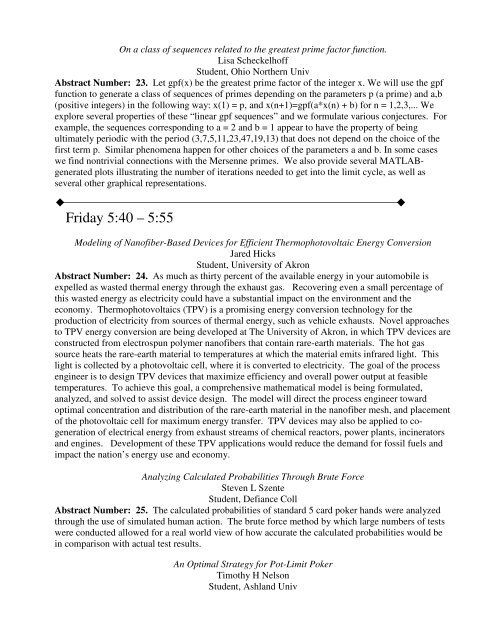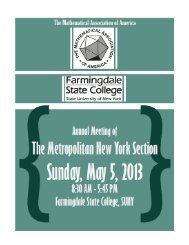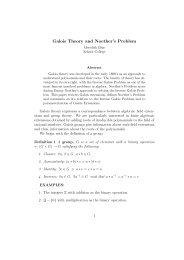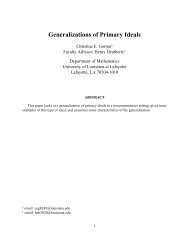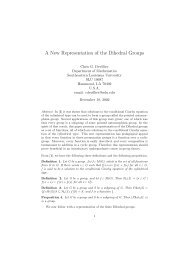Program - MAA Sections - Mathematical Association of America
Program - MAA Sections - Mathematical Association of America
Program - MAA Sections - Mathematical Association of America
You also want an ePaper? Increase the reach of your titles
YUMPU automatically turns print PDFs into web optimized ePapers that Google loves.
On a class <strong>of</strong> sequences related to the greatest prime factor function.<br />
Lisa Scheckelh<strong>of</strong>f<br />
Student, Ohio Northern Univ<br />
Abstract Number: 23. Let gpf(x) be the greatest prime factor <strong>of</strong> the integer x. We will use the gpf<br />
function to generate a class <strong>of</strong> sequences <strong>of</strong> primes depending on the parameters p (a prime) and a,b<br />
(positive integers) in the following way: x(1) = p, and x(n+1)=gpf(a*x(n) + b) for n = 1,2,3,... We<br />
explore several properties <strong>of</strong> these “linear gpf sequences” and we formulate various conjectures. For<br />
example, the sequences corresponding to a = 2 and b = 1 appear to have the property <strong>of</strong> being<br />
ultimately periodic with the period (3,7,5,11,23,47,19,13) that does not depend on the choice <strong>of</strong> the<br />
first term p. Similar phenomena happen for other choices <strong>of</strong> the parameters a and b. In some cases<br />
we find nontrivial connections with the Mersenne primes. We also provide several MATLABgenerated<br />
plots illustrating the number <strong>of</strong> iterations needed to get into the limit cycle, as well as<br />
several other graphical representations.<br />
Friday 5:40 – 5:55<br />
Modeling <strong>of</strong> Nan<strong>of</strong>iber-Based Devices for Efficient Thermophotovoltaic Energy Conversion<br />
Jared Hicks<br />
Student, University <strong>of</strong> Akron<br />
Abstract Number: 24. As much as thirty percent <strong>of</strong> the available energy in your automobile is<br />
expelled as wasted thermal energy through the exhaust gas. Recovering even a small percentage <strong>of</strong><br />
this wasted energy as electricity could have a substantial impact on the environment and the<br />
economy. Thermophotovoltaics (TPV) is a promising energy conversion technology for the<br />
production <strong>of</strong> electricity from sources <strong>of</strong> thermal energy, such as vehicle exhausts. Novel approaches<br />
to TPV energy conversion are being developed at The University <strong>of</strong> Akron, in which TPV devices are<br />
constructed from electrospun polymer nan<strong>of</strong>ibers that contain rare-earth materials. The hot gas<br />
source heats the rare-earth material to temperatures at which the material emits infrared light. This<br />
light is collected by a photovoltaic cell, where it is converted to electricity. The goal <strong>of</strong> the process<br />
engineer is to design TPV devices that maximize efficiency and overall power output at feasible<br />
temperatures. To achieve this goal, a comprehensive mathematical model is being formulated,<br />
analyzed, and solved to assist device design. The model will direct the process engineer toward<br />
optimal concentration and distribution <strong>of</strong> the rare-earth material in the nan<strong>of</strong>iber mesh, and placement<br />
<strong>of</strong> the photovoltaic cell for maximum energy transfer. TPV devices may also be applied to cogeneration<br />
<strong>of</strong> electrical energy from exhaust streams <strong>of</strong> chemical reactors, power plants, incinerators<br />
and engines. Development <strong>of</strong> these TPV applications would reduce the demand for fossil fuels and<br />
impact the nation’s energy use and economy.<br />
Analyzing Calculated Probabilities Through Brute Force<br />
Steven L Szente<br />
Student, Defiance Coll<br />
Abstract Number: 25. The calculated probabilities <strong>of</strong> standard 5 card poker hands were analyzed<br />
through the use <strong>of</strong> simulated human action. The brute force method by which large numbers <strong>of</strong> tests<br />
were conducted allowed for a real world view <strong>of</strong> how accurate the calculated probabilities would be<br />
in comparison with actual test results.<br />
An Optimal Strategy for Pot-Limit Poker<br />
Timothy H Nelson<br />
Student, Ashland Univ


